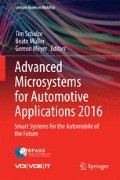Abstract
The continuous development and integration of Automated Driving Systems (ADS) leads to complex systems. The safety and reliability of such systems must be validated for all possible traffic situations that ADS may encounter on the road, before these systems can be taken into production. Test-driving with ADS functions requires millions of driving kilometers to acquire a sufficiently representative data set for validation. Modern cars produce huge amounts of sensor data. TNO analyses such data to distinguish typical patterns, called scenarios. The scenarios form the key input for validating ADS without the need of driving millions of kilometers. In this paper we present a newly developed technique for automatic extraction and classification of scenarios from real-life microscopic traffic data. This technique combines ‘simple’ deterministic models and data analytics to detect events hidden within terabytes of data.
Access this chapter
Tax calculation will be finalised at checkout
Purchases are for personal use only
Notes
- 1.
Hit rate is the percentage of actual events that has been detected.
- 2.
Precision is the percentage of events that has been correctly detected.
References
ERTRAC, Automated Driving Roadmap, Version 5.0. http://www.ertrac.org/uploads/documentsearch/id38/ERTRAC_Automated-Driving-2015.pdf. 21 July 2015
Bengler K, Dietmayer K, Farber B, Maurer M, Stiller C, Winner H (2014) Three decades of driver assistance systems: review and future perspectives. Intell Transp Syst Mag 6:6–22
Automated driving, Bosch now conducting tests on roads in Japan. Mobility Solutions, Bosch Media Service. http://www.bosch-presse.de/presseforum/details.htm?locale=en&txtID=7504
Elrofai H, Paardekooper J-P, Op den Camp O, Kalisvaart S, van Nunen E, Real-Life Scenario-Based Assessment Methodology for Automated Driving Systems, white paper, TNO, preprint
Kwakkernaat M, Bijlsma T, Ophelders F (2014) Layer-based multi-sensor fusion architecture for cooperative and automated driving application development. In: Advanced microsystems for automotive applications. Springer International Publishing, New York, pp 29–38
Salvucci D et al (2007) Lane-change detection using a computational driver model. Hum Factors J Hum Factors Ergon Soc 49(3):532–542
European Road Safety Observatory, SafetyNet (2007) http://ec.europa.eu/transport/wcm/road_safety/erso/index-2.html
UDRIVE, European naturalistic Driving Study. http://www.udrive.eu/index.php/about-udrive
Surface vehicle information report: Taxonomy and definitions for terms related to on-road motor vehicle automated driving systems. Issued Jan 2014. http://standards.sae.org/j3016_201401/
Author information
Authors and Affiliations
Corresponding author
Editor information
Editors and Affiliations
Rights and permissions
Copyright information
© 2016 Springer International Publishing AG
About this paper
Cite this paper
Elrofai, H., Worm, D., Op den Camp, O. (2016). Scenario Identification for Validation of Automated Driving Functions. In: Schulze, T., Müller, B., Meyer, G. (eds) Advanced Microsystems for Automotive Applications 2016. Lecture Notes in Mobility. Springer, Cham. https://doi.org/10.1007/978-3-319-44766-7_13
Download citation
DOI: https://doi.org/10.1007/978-3-319-44766-7_13
Published:
Publisher Name: Springer, Cham
Print ISBN: 978-3-319-44765-0
Online ISBN: 978-3-319-44766-7
eBook Packages: EngineeringEngineering (R0)

